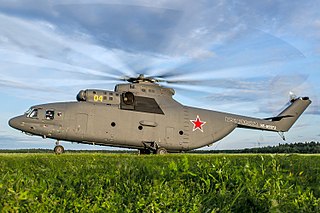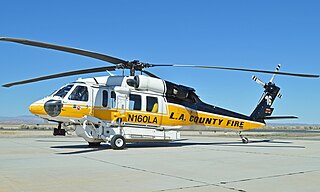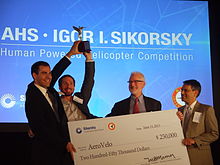
Sikorsky Aircraft is an American aircraft manufacturer based in Stratford, Connecticut. It was established by aviation pioneer Igor Sikorsky in 1923 and was among the first companies to manufacture helicopters for civilian and military use.
The CarterCopter is an experimental compound autogyro developed by Carter Aviation Technologies in the United States to demonstrate slowed rotor technology. On 17 June 2005, the CarterCopter became the first rotorcraft to achieve mu-1 (μ=1), an equal ratio of airspeed to rotor tip speed, but crashed on the next flight and has been inoperable since. It is being replaced by the Carter Personal Air Vehicle.

The Piasecki X-49 "SpeedHawk" is an American four-bladed, twin-engined experimental high-speed compound helicopter developed by Piasecki Aircraft. The X-49A is based on the airframe of a Sikorsky YSH-60F Seahawk, but utilizes Piasecki's proprietary vectored thrust ducted propeller (VTDP) design and includes the addition of lifting wings. The concept of the experimental program was to apply the VTDP technology to a production military helicopter to determine any benefit gained through increases in performance or useful load.

The Mil Mi-26 is a Soviet/Russian heavy transport helicopter. Its product code is Izdeliye 90. Operated by both military and civilian operators, it is the largest and most powerful helicopter to have gone into serial production.

The Sikorsky S-92 is an American twin-engine medium-lift helicopter built by Sikorsky Aircraft for the civil and military helicopter markets. The S-92 was developed from the Sikorsky S-70 helicopter and has similar parts such as flight control and rotor systems.

The Sikorsky S-70 is an American medium transport/utility helicopter family manufactured by Sikorsky Aircraft. It was developed for the United States Army in the 1970s, winning a competition to be designated the UH-60 Black Hawk and spawning a large family in U.S. military service. New and improved versions of the UH-60 have been developed since. Civilian versions, and some military versions, are produced under various S-70 model designations.

The Sikorsky CH-53K King Stallion is a heavy-lift cargo helicopter designed and produced by Sikorsky Aircraft. The King Stallion is an evolution of the long running CH-53 series of helicopters which have been in continuous service since 1966, and features three uprated 7,500 shp (5,590 kW) engines, new composite rotor blades, and a wider aircraft cabin than its predecessors. It is the largest and heaviest helicopter in the U.S. military.

The Vertical Flight Society, formerly the American Helicopter Society (AHS), is the non-profit technical society for the advancement of vertical flight. It has 21 different technical committees and two dozen active chapters around the world. There are over 100 Corporate Members and 28 Educational Members.

The Igor I. Sikorsky Human Powered Helicopter Competition was established in 1980 by the American Helicopter Society (AHS) International. The award, the AHS Sikorsky Prize, was given for the first human powered helicopter (HPH) to meet a set of extremely challenging flight requirements. In summary, the requirements to win the AHS Sikorsky Prize included a flight duration of 60 seconds and reaching an altitude of 3 meters, with the center point of the aircraft hovering over a 10-by-10-metre square.

A human-powered helicopter (HPH) is a helicopter powered solely by one or more humans carried on board. As in other human-powered aircraft, the power is usually generated by pedalling. It remains a considerable engineering challenge to obtain both the power-to-weight ratio and rotor efficiency required to sustain a helicopter in flight.

The Sikorsky S-69 is an American experimental co-axial compound helicopter developed by Sikorsky Aircraft as the demonstrator of the Advancing Blade Concept (ABC) under United States Army and NASA funding.

A helicopter is a type of rotorcraft in which lift and thrust are supplied by horizontally spinning rotors. This allows the helicopter to take off and land vertically, to hover, and to fly forward, backward and laterally. These attributes allow helicopters to be used in congested or isolated areas where fixed-wing aircraft and many forms of short take-off and landing (STOL) or short take-off and vertical landing (STOVL) aircraft cannot perform without a runway.

The Sikorsky X2 is an experimental high-speed compound helicopter with coaxial rotors, developed by Sikorsky Aircraft, that made its first flight in 2008 and was officially retired in 2011.

The Airbus Helicopters H175 is a 7-ton class super-medium utility helicopter produced by Airbus Helicopters. In China, the H175 is produced by the Aviation Industry Corporation of China (AVIC) as the Avicopter AC352. Originally launched as the Eurocopter EC175 and the Harbin Z-15, it has been referred to as being a 'super-medium' helicopter.

The Sikorsky S-97 Raider is a high-speed scout and attack compound helicopter based on the Advancing Blade Concept (ABC) with a coaxial rotor system under development by Sikorsky Aircraft. Sikorsky planned to offer it for the United States Army's Armed Aerial Scout program, along with other possible uses. The S-97 made its maiden flight on 22 May 2015.

The University of Maryland Gamera I is a human-powered helicopter designed to win the $250,000 Sikorsky Prize.
The University of Maryland Gamera II is an improved human-powered helicopter designed to win the US$250,000 Sikorsky Prize.

The Bell V-280 Valor is a tiltrotor aircraft being developed by Bell Helicopter and Lockheed Martin for the United States Army's Future Vertical Lift (FVL) program. The aircraft was officially unveiled at the 2013 Army Aviation Association of America's (AAAA) Annual Professional Forum and Exposition in Fort Worth, Texas. The V-280 made its first flight on 18 December 2017 in Amarillo, Texas.

The Sikorsky/Lockheed Martin VH-92 Patriot is an American helicopter under development to replace the United States Marine Corps' Marine One U.S. presidential transport fleet. It is a militarized variant of the Sikorsky S-92.


















